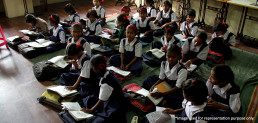In the U.S., 1 in 4 girls and 1 in 13 boys are estimated to experience abuse. At the same time, globally, more than 1 billion children are at risk of sexual violence, according to the World Health Organization. This underlines the urgent need for child abuse prevention efforts, particularly in homes and schools.
Creating safe spaces and fostering open communication can protect children and promote a healthy and safe school environment. Keep reading to learn more about how to prevent child abuse and ensure the well-being of children in every community.
Understanding the Importance of Child Abuse Prevention
Child abuse prevention is an important aspect of ensuring children grow up in a safe and supportive environment. It protects their physical, emotional, and mental well-being, allowing them to thrive. Schools and communities play a key role in creating a safe school environment by providing resources, raising awareness, and fostering open communication.
Signs of Abuse: Recognizing When a Child May Be at Risk
Recognizing the signs of abuse is important for child abuse prevention and ensuring a safe school environment. Here are some key indicators to watch for:
- If a child becomes withdrawn, anxious, or excessively fearful, it may be a sign they are experiencing abuse. This change can affect their engagement in school, undermining a healthy and safe school environment.
- Bruises, burns, or other marks the child cannot explain or tries to cover up should raise concern. A safe school environment means noticing these signs and taking action.
- Children who have experienced abuse may tell conflicting or inconsistent stories about how an injury happened. It’s important to listen closely to what they are saying.
- Children who have been abused may find it hard to trust teachers, counselors, or other adults. Offering them a safe space is vital for building that trust.
- Abuse can lead to emotional distress, making it difficult for children to concentrate or complete schoolwork. A healthy and safe school environment includes addressing these emotional needs.
How to Foster a Safe School Environment for Children
Creating a safe school environment goes beyond just policies—it’s about fostering a community where children feel supported, protected, and respected. Here are some steps to achieve that:
- Teachers and staff should be trained in child abuse prevention to identify any signs of abuse or neglect and take immediate action.
- Encourage students to respect each other’s differences and teach empathy through activities and programs that support a healthy and safe school environment.
- Make it easy for children and staff to report any safety concerns. Clear and confidential channels help maintain trust and ensure immediate responses to potential issues.
- Regularly involve parents, local organizations, and the community in school activities to strengthen safety and well-being.
- Offer counseling and mental health services to help students manage stress, anxiety, or challenges.
Practical Steps for Building a Healthy and Safe School Environment
Creating a healthy and safe school environment is essential for the well-being and development of students. It helps ensure that children feel supported, valued, and protected. Here are some practical steps you can take to build such an environment in your school:
- Encourage students to speak up if they feel unsafe or uncomfortable.
- Set rules and procedures to address bullying, harassment, and abuse.
- Train teachers and staff on child abuse prevention, how to recognize signs of abuse, and how to handle sensitive situations.
- Set up counseling services and safe spaces where students can discuss their problems.
- Engage with parents and local organizations to build a strong support system.
Encouraging Open Communication Between Children, Teachers, and Parents
Open communication between children, teachers, and parents is crucial for creating a healthy and safe school environment. When all parties are actively involved and have a clear channel for dialogue, it becomes easier to address concerns and prevent issues like child abuse.
Regular discussions between parents and teachers also help identify signs of distress early, ensuring that children are safe and their well-being is prioritized at school and home.
Creating Safe Spaces at Home: Tips for Parents
Creating a safe space at home is essential for your child’s well-being and emotional development. By setting clear boundaries and offering support, you can play an important role in child abuse prevention and provide a nurturing, secure environment for your child. Here are some simple steps you can take to help ensure your home is a safe space:
- Establish clear, consistent rules and expectations. Help your child understand what is acceptable behavior and what isn’t.
- Keep an eye on what your child watches on TV, plays video games, or sees online.
- Teach your child to respect boundaries in friendships and relationships and to recognize healthy and unhealthy behaviors.
- Stay connected with your child’s school and teachers to ensure a safe school environment.
The Role of Cry America in Preventing Child Abuse
CRY America plays an important role in child abuse prevention by addressing systemic issues that make children vulnerable. By creating awareness, advocating for child rights, and collaborating with communities, CRY America helps ensure a safe school environment and promotes awareness about abuse prevention.
Moreover, we collaborate with local schools, government agencies, and communities to implement child protection policies. This includes teacher training, parent workshops, and resource allocation to build safe spaces for children.
FAQs
How can schools create a safe environment to prevent child abuse?
Schools can establish a safe school environment by implementing strict policies against abuse, conducting background checks for staff, and ensuring regular teacher training on recognizing and responding to abuse. Creating open channels for students to report concerns and fostering a healthy and safe school environment builds trust and reduces risks of abuse.
What steps can parents take to create a safe space for their children at home?
Parents can build a safe home environment by maintaining open communication, listening actively, and educating their children about personal safety. Setting clear boundaries and monitoring interactions with others are essential aspects of child abuse prevention at home.
Why is open communication important in preventing child abuse?
Open communication encourages children to share concerns without fear, making identifying and addressing any issues easier. It is a critical part of child abuse prevention, helping children feel safe and supported in disclosing uncomfortable situations.
How can technology be used to monitor and prevent child abuse?
Technology can help prevent child abuse by enabling monitoring tools like parental controls and online activity tracking. Schools and parents can also use educational apps to teach children about safety and alert them to risks in a healthy and safe school environment.
What resources are available for child abuse prevention in schools and communities?
Schools and communities can access resources like counseling programs, abuse prevention workshops, and helplines to protect children. Partnerships with child protection agencies and regular training sessions further strengthen child abuse prevention efforts.
Recommended for you



















































